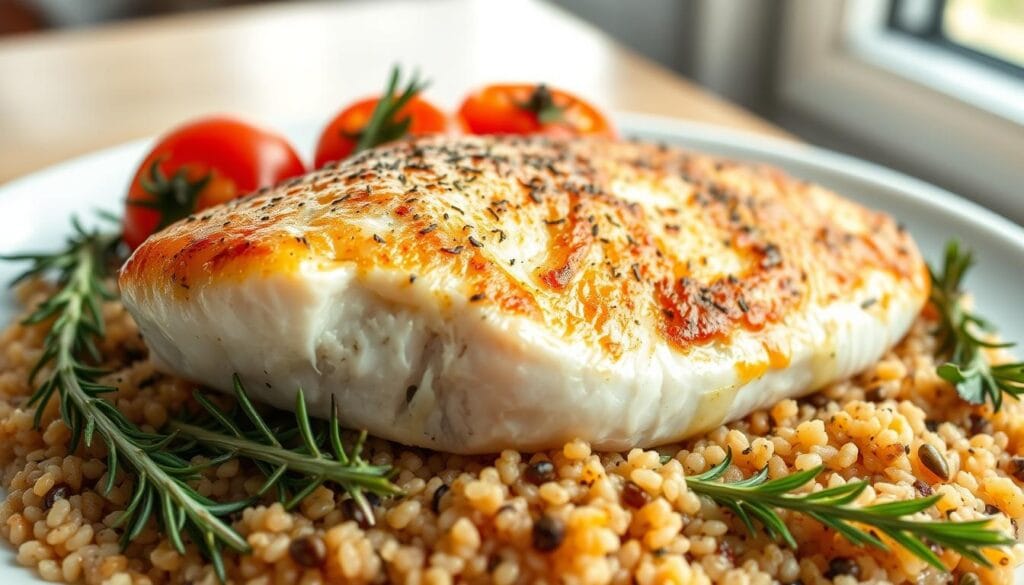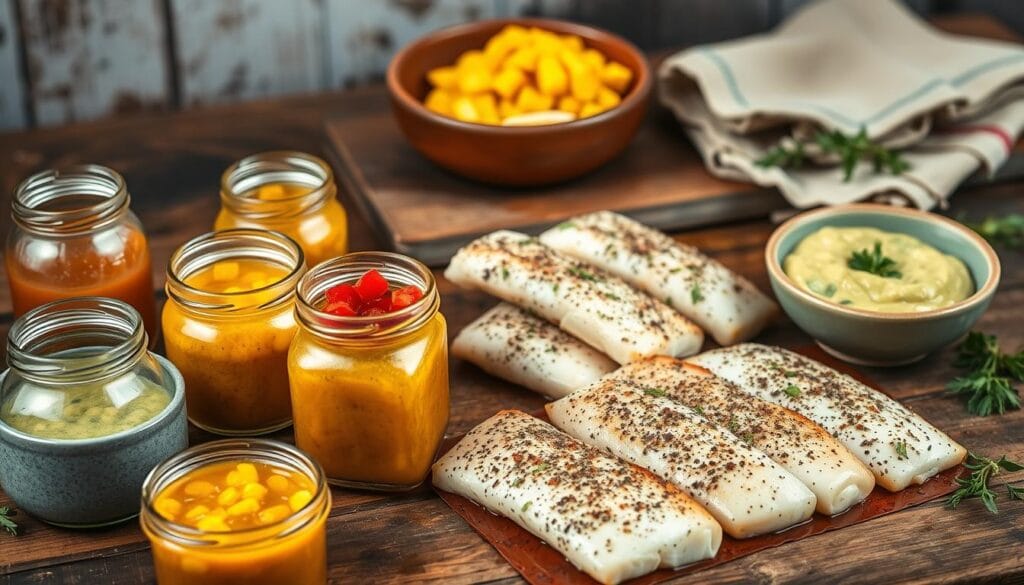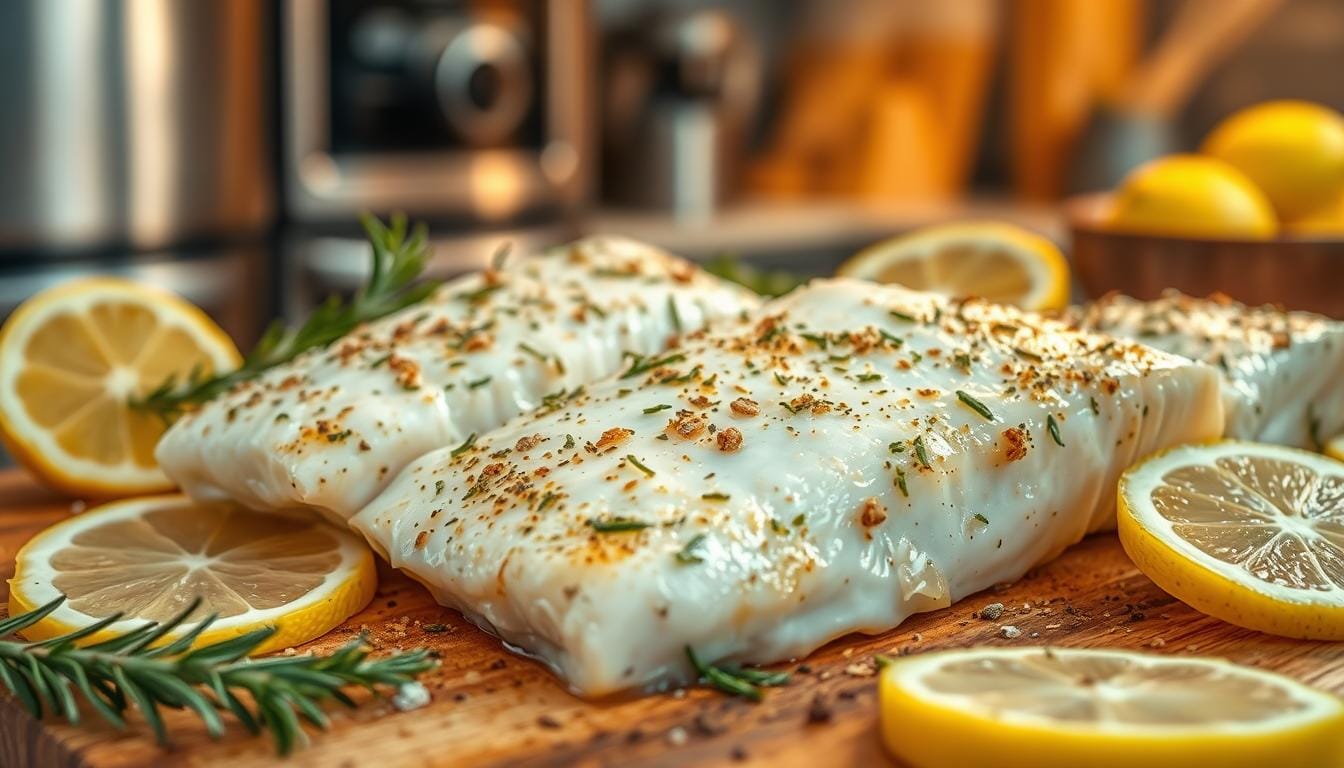The ocean whispers its secrets through every delicate bite of mahi mahi. I remember my first encounter with this incredible fish during a coastal vacation. The local chef turned a simple baked mahi mahi recipe into a culinary masterpiece. It changed my perception of seafood forever.
Table of Contents
Baked mahi mahi recipes let home cooks create restaurant-quality meals with little effort. Whether you love seafood or are just curious, these healthy mahi mahi recipes will take your dinner game to the next level. They introduce you to a world of vibrant flavors.
Mahi mahi’s versatility makes it perfect for your culinary creativity. Each recipe offers a perfect balance of nutrition and taste. It will make your taste buds dance with excitement.
Key Takeaways
- Mahi mahi is a versatile and delicious seafood option
- Baked mahi mahi recipes are simple to prepare
- Healthy cooking methods preserve fish’s natural flavors
- Multiple cuisine styles work well with mahi mahi
- Fresh ingredients enhance the fish’s natural taste
Understanding Mahi Mahi: A Premium Seafood Choice
Dive into the world of mahi mahi, a spectacular seafood option. It turns easy baked mahi mahi recipes into culinary masterpieces. This tropical fish brings excitement to your dining table with its unique characteristics and versatile flavor profile.
Mahi mahi, which means “strong-strong” in Hawaiian, is a saltwater fish. It’s prized by chefs and home cooks alike. Its firm texture and mild sweet taste make it perfect for creating flavorful mahi mahi dishes that appeal to seafood lovers of all levels.
What Makes Mahi Mahi Special
The distinctive qualities of mahi mahi set it apart from other fish varieties:
- Firm, meaty texture ideal for baking
- Mild, slightly sweet flavor
- Versatile cooking options
- Bright, colorful appearance
Selecting Fresh vs. Frozen Mahi Mahi
When choosing mahi mahi for your recipes, consider these selection tips:
- Fresh mahi mahi should have a clean, ocean-like smell
- Look for bright, vibrant skin with no discoloration
- Frozen mahi mahi can be equally delicious when properly stored
- Check for firm, translucent flesh without browning
Nutritional Benefits of Mahi Mahi
Not only delicious, mahi mahi is packed with essential nutrients. Rich in protein and low in calories, this fish offers remarkable health benefits for those seeking nutritious meal options.
| Nutrient | Amount per 3 oz serving |
|---|---|
| Protein | 20g |
| Calories | 90 |
| Omega-3 Fatty Acids | 0.5g |
Whether you’re a seafood enthusiast or a curious home cook, mahi mahi promises an exceptional dining experience. It offers unique flavor and nutritional profile.
Essential Ingredients for Perfect Baked Mahi Mahi
Starting with the right ingredients is key to making delicious mahi mahi meals. Your oven-baked mahi mahi will stand out with fresh, high-quality parts. These parts should match the fish’s light taste.
Here are the must-haves for your mahi mahi recipe:
- Fresh Herbs: Thyme, parsley, and dill add lively tastes
- Citrus: Lemon and lime make the fish tender and bright
- Quality olive oil for moisture and richness
- Seasonings like garlic, smoked paprika, and black pepper
- Butter for a smooth, luxurious feel
Keep these key ingredients in your pantry. They help make a tasty oven-baked mahi mahi quickly. Each part is important for enhancing the fish’s taste and making a great seafood dish.
Pro tip: Always use fresh herbs and high-quality spices for the most robust flavor profile.
When you’re prepping your mahi mahi, remember to balance everything. The right mix of herbs, citrus, and seasonings turns a simple dish into a showstopper. It will wow your family and guests.
Classic Lemon Butter Baked Mahi Mahi Recipe
Discover the ultimate simple mahi mahi recipe that turns this fish into a culinary masterpiece. This recipe combines fresh ingredients with precise cooking techniques. It creates a mouth-watering dish that will impress your dinner guests.
Preparing a delicious mahi mahi dish is easy. This classic recipe mixes the bright flavors of lemon and the richness of butter. It elevates the natural taste of the fish.
Preparation Steps
- Select fresh mahi mahi fillets (approximately 6 oz each)
- Pat the fish dry with paper towels
- Prepare a baking dish with light olive oil or parchment paper
- Arrange fillets in a single layer
Cooking Temperature and Time
| Fillet Thickness | Cooking Temperature | Cooking Time |
|---|---|---|
| 1/2 inch | 400°F | 10-12 minutes |
| 1 inch | 400°F | 15-20 minutes |
Seasoning Tips
Enhance your simple mahi mahi recipe with these expert seasoning recommendations:
- Sprinkle fresh lemon zest for brightness
- Use unsalted butter for controlled seasoning
- Add minced garlic for depth of flavor
- Incorporate fresh thyme or parsley
- Season with smoked paprika and black pepper
Pro tip: The best baked mahi mahi recipe requires careful attention to cooking time. Watch for the fish to become opaque and flake easily with a fork. This means it’s perfectly cooked.
Asian-Inspired Parchment Paper Mahi Mahi
Take your baked mahi mahi to the next level with an Asian twist. Parchment paper baking keeps the fish moist and adds a burst of flavor. It’s a simple yet elegant way to make your dish stand out.
This method is all about keeping things simple. The parchment paper packets trap all the tasty flavors. Your mahi mahi will stay tender and juicy, with your kitchen smelling amazing.
Essential Ingredients for Your Parchment Paper Mahi Mahi
- Fresh mahi mahi fillets
- Soy sauce
- Rice wine vinegar
- Fresh ginger
- Garlic powder
- Honey
- Julienned vegetables
Making these dishes is surprisingly easy. Begin by setting up your parchment paper packets. Put your mahi mahi in the middle, then add sliced veggies and your marinade.
“Parchment paper cooking is like a culinary love letter to your taste buds” – Chef Michelle Rodriguez
Close the packets well, leaving space for steam. Bake at 400°F for 12-15 minutes. When you open them, you’ll enjoy a mix of aromas that make these recipes unforgettable.
Pro Cooking Tips
- Choose fresh, high-quality mahi mahi
- Don’t overcrowd the parchment packet
- Use sharp knife for precise vegetable cuts
- Let fish rest for 2-3 minutes after cooking
Tip: For an extra layer of flavor, sprinkle toasted sesame seeds or green onions before serving.
Baked Mahi Mahi Recipes with Mediterranean Flavors
Make your healthy mahi mahi recipe shine with Mediterranean flavors. These dishes bring the taste of the coast to your dinner. They turn a simple fish into a work of art.
Mediterranean cooking is all about fresh ingredients and simple ways to cook. Mahi mahi’s mild taste is perfect for these rich flavors.
Mediterranean Herb Combinations
Try these classic Mediterranean herb mixes for a burst of flavor:
- Dried oregano and fresh basil
- Lemon zest with chopped parsley
- Rosemary and thyme mixture
- Fennel seeds with garlic powder
Innovative Cooking Techniques
Here’s how to cook your Mediterranean mahi mahi to perfection:
- Preheat your oven to 400°F for the best results
- Use parchment paper to keep moisture in
- Drizzle with extra virgin olive oil
- Sprinkle herbs generously before baking
Your Mediterranean mahi mahi will be a healthy and tasty meal. It will take you to the sunny coasts of Greece and Italy.
Simple Tomato and Herb Baked Mahi Mahi

Take your seafood dinner to the next level with this easy baked mahi mahi recipe. It combines fresh herbs and cherry tomatoes to make a dish that’s both flavorful and simple to make.
To make this tasty meal, you’ll need a few ingredients:
- Fresh mahi mahi fillets
- Assorted cherry tomatoes (red, yellow, and orange)
- Fresh herbs like basil and thyme
- Garlic powder
- Sea salt and black pepper
- Ground cumin
- Olive oil
First, preheat your oven to 400°F. Dry the mahi mahi fillets and season them with garlic powder, salt, black pepper, and a bit of cumin. The right mix of spices brings out the fish’s natural taste.
Place the seasoned fillets in a baking dish. Add a colorful mix of cherry tomatoes around them. Drizzle with olive oil and sprinkle fresh herbs on top. Pro tip: Let the tomatoes roast until they start to burst, releasing their sweet, concentrated flavors.
Bake for 12-15 minutes, or until the fish is opaque and flakes easily. This dish is stunning and delicious, great for a quick dinner or a special meal for guests.
Professional Tips for Perfectly Cooked Fish
Cooking mahi mahi well needs precision and care. Whether you’re making the best baked mahi mahi recipe or trying oven-baked mahi mahi, these tips will help you get great results. You’ll make dishes that taste like they’re from a restaurant.
“Cooking fish is an art that demands attention to detail and understanding of temperature and moisture.” – Culinary Expert
Precise Temperature Management
When cooking mahi mahi, controlling the temperature is key. The perfect internal temperature is 137°F. Here are some strategies for accurate cooking:
- Use a digital meat thermometer for precise readings
- Insert the thermometer into the thickest part of the fish
- Check temperature without moving the fish too much
- Remove fish from oven when it reaches 135°F to prevent overcooking
Maintaining Moisture While Baking
Keeping the fish moist is crucial for a tasty oven-baked mahi mahi. Try these techniques to manage moisture:
- Wrap fish in parchment paper to lock in natural juices
- Brush with olive oil or butter before baking
- Avoid overcooking by monitoring cooking time
- Let fish rest for 3-5 minutes after baking to redistribute moisture
By using these professional tips, you’ll make your best baked mahi mahi recipe amazing. Your seafood dish will be tender and full of flavor every time.
Complementary Side Dishes and Pairings
Creating the perfect healthy mahi mahi recipe is more than just the fish. The right side dishes can make your meal truly special. Choose options that match the fish’s light taste and texture.
Your mahi mahi needs side dishes that bring out its best flavor. Here are some top picks:
- Instant Pot Basmati Rice: A light and fluffy base that doesn’t overpower the fish
- Roasted Vegetables: Colorful and nutrient-dense options like bell peppers and asparagus
- Low-Carb Alternatives: Cauliflower rice or zucchini noodles for health-conscious diners
- Fresh Green Salad: A crisp side that adds brightness to your plate
Choosing the right drink can make your meal even better. Light white wines like Sauvignon Blanc or Pinot Grigio pair well with the fish’s flavor.
| Side Dish Category | Best Pairings | Flavor Profile |
|---|---|---|
| Grains | Basmati Rice | Mild, Neutral |
| Vegetables | Roasted Asparagus | Earthy, Slightly Bitter |
| Low-Carb Options | Cauliflower Rice | Light, Neutral |
Pro tip: Always aim for balance in your plate. The side dishes should enhance, not overshadow, the star of your meal – the mahi mahi.
Sauce and Marinade Options

Improving your baked mahi mahi recipes starts with the right marinades and sauces. The key to making a simple fish dish great is using the right flavor enhancers. These should match mahi mahi’s light taste.
Quick Marinades to Enhance Flavor
Make delicious mahi mahi dishes with these easy marinades:
- Citrus Burst: Mix lemon juice, olive oil, garlic, and herbs
- Tropical Blend: Combine pineapple juice, soy sauce, and ginger for a mix of sweet and savory
- Herb-Infused: Whisk white wine, thyme, and parsley together
Marinating your mahi mahi for 15-30 minutes before baking keeps it moist. It also brings out the fish’s natural flavor.
Finishing Sauces to Elevate Your Dish
Take your baked mahi mahi recipes to the next level with these tasty finishing sauces:
- Creamy Dill Sauce: Mix Greek yogurt, fresh dill, and lemon zest
- Mango Salsa: Blend diced mango, red onion, cilantro, and lime juice
- Garlic Butter Sauce: Use melted butter, roasted garlic, and parsley
Drizzle your chosen sauce just before serving. This keeps your mahi mahi dishes perfect in texture and temperature.
Storage and Reheating Guidelines
Keeping your easy baked mahi mahi fresh is important. After you’ve enjoyed your simple mahi mahi recipe, you’ll want to keep the leftovers tasty. This way, you can enjoy it again in the future.
Refrigeration is crucial for keeping your mahi mahi fresh. Here are some tips to help you store it right:
- Store in an airtight container
- Refrigerate within 2 hours of cooking
- Keep in the coldest part of your refrigerator
- Consume within 2-3 days for optimal taste and texture
Freezing is a great option for longer storage. Wrap the mahi mahi tightly in plastic wrap or aluminum foil. Then, put it in a freezer-safe container. It can stay frozen for up to 3 months without losing much quality.
When reheating, be gentle to avoid drying out the fish. The best way is to use an oven:
- Preheat oven to 350°F
- Place fish in a baking dish
- Cover with aluminum foil to retain moisture
- Heat for 10-15 minutes until warmed through
Pro tip: Try to avoid microwaving if you can. It can dry out the fish quickly. You want to keep the moist, flaky texture of your original simple mahi mahi recipe.
Health Benefits and Dietary Considerations
Mahi mahi is a nutritional powerhouse for those who love seafood. It’s packed with nutrients that support your health. When you make it with a healthy recipe, it’s a great choice for a nutritious meal.
The nutritional benefits of mahi mahi are amazing. It’s full of essential nutrients that can boost your diet:
- High-quality protein for muscle maintenance
- Omega-3 fatty acids supporting heart health
- Selenium for immune system support
- Phosphorus for strong bones and teeth
Mahi mahi is great for many diets. It fits well into low-carb, keto, and Mediterranean diets.
| Nutrient | Amount per 3 oz Serving | Health Benefit |
|---|---|---|
| Protein | 20g | Muscle growth and repair |
| Omega-3 | 250mg | Heart and brain health |
| Selenium | 50mcg | Antioxidant protection |
Aim for 2-3 servings of oven-baked mahi mahi a week. This helps you get the most nutritional benefits. Talk to a healthcare professional to find the right portion sizes for you.
Pro tip: Choose wild-caught mahi mahi for the most nutrient-dense option and sustainable seafood choice.
Conclusion
Your journey with baked Mahi Mahi recipes is just beginning. It’s not just about following a recipe. It’s about discovering new flavors and mastering cooking techniques. These recipes, from Mediterranean to Asian, cater to every taste.
Mahi Mahi is perfect for home cooks looking for both taste and nutrition. Whether you’re experienced or new to cooking, you can make amazing dishes. Each recipe lets you try different seasonings and cooking styles.
Cooking is a journey of learning and fun. Your Mahi Mahi dishes will get better with time. Share your creations and add your own twist to these recipes.
Now, you’re ready to make delicious Mahi Mahi meals. Start experimenting, trust your taste, and enjoy the process. Have fun exploring the world of baked Mahi Mahi cooking!
FAQ
What is mahi mahi and why is it a good fish to bake?
Mahi mahi is a firm, mild-flavored fish perfect for baking. Its sturdy texture holds up well during cooking. Its subtle taste makes it versatile for various recipes.
It’s rich in protein and a healthy choice for seafood lovers. It’s easy to prepare and delicious.
How do I know if I’m buying fresh mahi mahi?
Look for fresh mahi mahi with a bright, translucent appearance. It should have a clean, mild ocean smell. The flesh should be firm and spring back when touched.
Avoid fish with strong fishy odor, discoloration, or browning. If buying frozen, check for intact packaging and no freezer burn.
What are the best ways to season mahi mahi?
Mahi mahi loves citrus flavors, herbs like basil and parsley, and light seasonings. Try lemon butter, Mediterranean herbs, or Asian marinades with ginger and soy sauce. The goal is to enhance its natural flavor without overpowering it.
What’s the ideal baking temperature for mahi mahi?
Bake mahi mahi at 400°F (204°C) for 10-12 minutes. The internal temperature should be 145°F (63°C) for it to be fully cooked but still moist. Use a meat thermometer to check and avoid overcooking, which can dry out the fish.
Can I freeze baked mahi mahi?
Yes, you can freeze baked mahi mahi. Cool it completely, then store it in an airtight container or freezer bag. It keeps for up to 3 months. Thaw in the fridge overnight and warm gently in the oven to prevent drying out.
Is mahi mahi a healthy fish to eat?
Absolutely! Mahi mahi is a lean protein source, rich in vitamin B12, selenium, and omega-3 fatty acids. It’s low in calories and saturated fat, making it heart-healthy for a nutritious diet.
What are some easy side dishes to serve with baked mahi mahi?
Great side dishes include roasted vegetables, quinoa salad, steamed rice, and Mediterranean-style couscous. You can also pair it with grilled asparagus, roasted sweet potatoes, or a fresh citrus slaw. These options complement the fish’s mild flavor.
How can I prevent my mahi mahi from drying out while baking?
To keep mahi mahi moist, try baking in parchment paper or adding a light butter or olive oil coating. Use a marinade before cooking. Avoid overcooking by monitoring the internal temperature and removing the fish from the oven as soon as it reaches 145°F (63°C).


